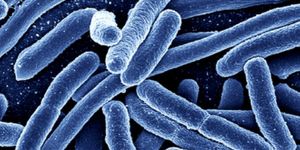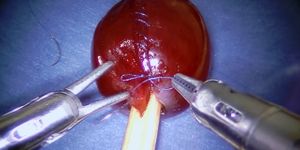Gold Nanoparticles Destroy Cancer in Mice
Researchers at a University of Colorado Cancer Center want to perfect the use of gold nanoparticles in cancer therapeutics. They have engineered a tool that can target tumor cells, and destroy them. Their findings have been reported in the journal Bladder Cancer.
Gold has special properties that make it attractive for use as a delivery system in human patients, like being small and non-toxic. Molecules are attached to the gold particles, and they are then imbued with the abilities to carry out anti-cancer functions. In this work, scientists at CU Cancer Center made a particle that can recognize and attach to a protein called EGFR - an EGFR antibody. The EGFR protein is present on the cells of tumors, but not healthy cells, in the bladder. That antibody can be coupled with chemotherapy agents in the gold nanoparticle delivery system that can target tumors cells directly.
The researchers wanted to take it a step further and imbue the gold nanoparticles with the ability to destroy tumors as well. They used something called plasmon resonance, in which nanoparticles vibrate in response to certain light frequencies. The investigators tuned their gold nanoparticles so they would undergo plasmon resonance, a type of energy transfer, in response to near infrared light. The light itself is safe, but when the tuned gold nanoparticles were exposed to it, they became excited, heated up and blasted the nearby tissue.
Because the mice in this research had very small bladder tumors, the researchers had to use bioluminescence to evaluate the efficacy of their new technique. Basically, in this system, the more a bladder glows, the more cancer is present, and if the nanoparticles kill cancer cells, the bladder will emit less light.
After comparing mice that got an EGFR-directed nanoparticle injection coupled with laser light to mice that had only been exposed to laser light, it was found that the mice treated with nanoparticles did have less light emitting from their cancerous bladders. The tumors also glowed less than they had prior to the treatment, suggesting that the method can slow or even reverse tumor growth, with minimal side effects.
"We are highly encouraged by these results," commented Thomas Flaig, MD, Associate Dean for Clinical Research at University of Colorado School of Medicine and Chief Clinical Research Officer of UCHealth. This work is the product of a collaboration between Flaig and Won Park, Ph.D., the N. Rex Sheppard Professor in the Department of Electrical, Computer & Energy Engineering at CU Boulder.
"It's one of the great stories in scientific collaboration - Won was on a sabbatical of sorts here on campus and we sat down and started talking about ideas around our mutual interests. How could we bring the nanorods to a tumor? The answer was EGFR. What cancer site would allow us to deliver infrared light? Oh, the bladder! And how would we deliver it? Well, in bladder cancer there are already lights on the scopes used in clinical practice that could do the job. It's been an interesting problem-solving experience pursuing this technique from a futuristic idea to something that now shows real promise in animal models," Flaig said.
Find out more about how gold nanoparticles are used to destroy cancer from this video, which discusses how the technique is applied to prostate cancer.
Sources: AAAS/Eurekalert! Via UC Denver, Wikipedia, Bladder Cancer









